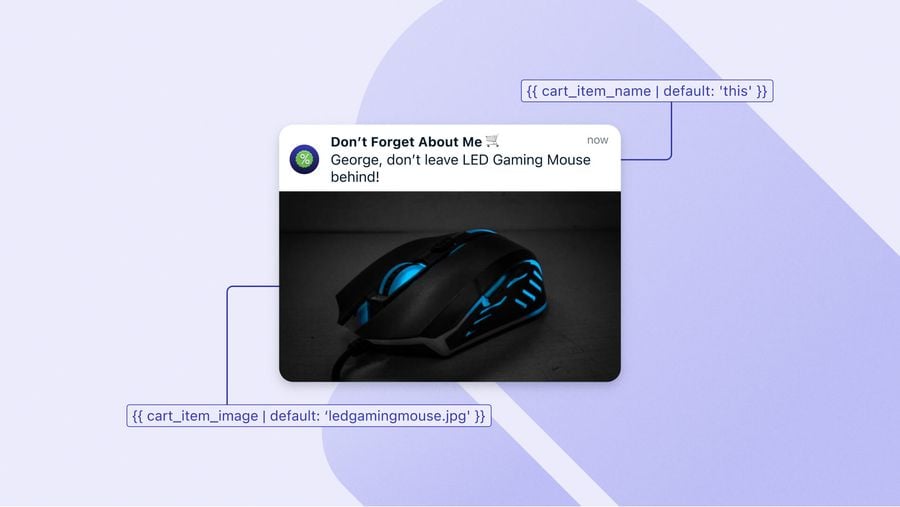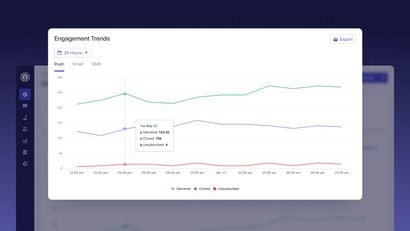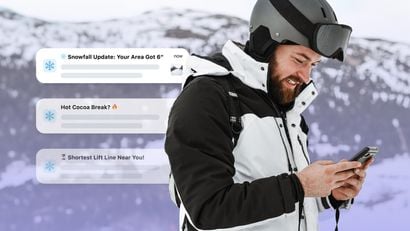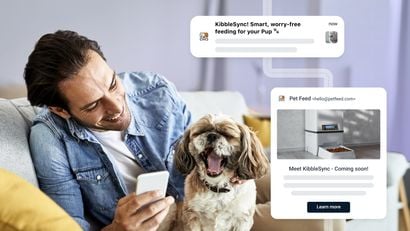The average smartphone user will receive 46 push notifications in a single day. From a marketing perspective, that’s 46 opportunities to engage your users and drive conversions. But let’s face it, for consumers, this could easily become 46 reasons to uninstall your mobile app. And that number is only counting push notifications, not the dozens of transactional or promotional messaging sent over email, SMS, and in-app messaging.
So, if the world at large is already accustomed to ingesting content through a digital firehose, then marketers must do what they’ve been doing for decades already: adapt to meet users in new and meaningful ways. For mobile-first companies, this means designing their user engagement strategies around highly relevant and personalized messaging.
What is Message Personalization, and Why is it Important?
Message personalization is the practice of tailoring marketing messages to individual customers based on their specific needs, interests, behaviors, and preferences. At its core, this is achieved through the collection and segmentation of customer data. Through this data, businesses can tailor marketing efforts to the users most likely to take action, based on past behavior. History repeats itself, and so do our shopping habits.
Message personalization effectively helps your customers feel like your platform is fashioning itself around to lives and not the other way around. The more convenient, timely, and contextual your messaging strategy is, the better your users feel you understand them, and the more likely they are to continue their relationship with you. Relationships are built on both parties feeling heard — does your current marketing strategy embody this across all channels?
Personalized messaging can be implemented in almost every facet of your marketing strategy and has been proven to improve open rates, nurture engagement, drastically boost app retention, and build lasting trust with customers.
How to Collect Customer Data for Personalization: Best Practices
You can’t tailor your messaging to the unique needs and preferences of your users if you don’t know what those unique needs and preferences are in the first place. Within the personalization battle plan of “ready, aim, fire,” collecting customer data represents the critical second step.
What Types of Data are Valuable to Collect?
First-party data — Highly accurate (and typically the most reliable) customer data collected directly by your company. First-party data is gathered via direct interaction with your users and is often sourced from lead forms, email communications, surveys, ad interactions, social media interactions, and any actions your users take on your app or website. Remember, this data must always be collected with user consent.
Second-party data — Indirectly collected data from trusted partners. Second-party data is essentially someone else's first-party data that they have chosen to share with another organization.
For example, a retailer might partner with a manufacturer to share customer data to improve their understanding of their customers. The manufacturer may provide the retailer with information such as customer demographics, purchase history, or product preferences, which the retailer can use to personalize their marketing efforts.
Second-party data is typically considered more reliable and valuable than third-party data, as it comes from a trusted source and is often more targeted and relevant to the specific needs of the organization.
Third-party data — Collected by an aggregator or other independent sources who do not have personal relationships with your specific audience. Third-party data is organized and presented by data processors who compile their statistics from several sources and either sell it to your company or make it publicly available. This may include survey responses, website activity, or broader information such as age, income, and education.
Below we’ve laid out some of the ways to collect customer data for personalization:
- Website Analytics: Website analytics tools such as Google Analytics can help you track customer behavior on your website. Here you can explore which pages customers visit most, how long they stay on each page, and what actions they take while on your site.
- App Analytics: Customer engagement and messaging solutions often provide built-in analytics that help companies track specific in-app behaviors and leverage that data to enhance and personalize the user experience and target promotions.
- Customer Surveys: Surveys can provide you with valuable first-party insights into customer needs and expectations. Online survey tools such as SurveyMonkey, Typeform, or Google Forms are some of the most popular ways to collect customer feedback via email. Other engagement solutions like OneSignal make it easy to execute in-app surveys to collect feedback from engaged users.
- Social Media: Social media platforms like Facebook, Twitter, and Instagram can provide you with insights into evolving customer interests and up-to-date behavior.
- Customer Support: Interacting directly with customers through customer support channels can provide you with valuable insights into customer pain points and preferences. This data can be used to personalize your marketing campaigns.
Data Privacy and Security Considerations
Yes, collecting customer data is a massive part of any personalized marketing campaign. However, users today are more protective than ever with their data, and for good reason. As more of our lives rely on constant online connection, more of our private data is subject to abuse.
85% of adults want to do more to protect their online privacy.
When collecting and using user data, businesses and organizations must comply with various laws and regulations, including:
1. General Data Protection Regulation (GDPR): The GDPR is a regulation that sets guidelines for the collection, processing, and storage of personal data of individuals within the European Union (EU). It requires businesses to obtain user consent, provide transparency about how data is being collected and used, and give users the right to access, modify, or delete their personal data.
2. California Consumer Privacy Act (CCPA): The CCPA is a regulation that gives California residents the right to know what personal data is being collected about them, and the right to request that their data be deleted. It also requires businesses to provide clear and transparent privacy policies. The California Privacy Rights Act (CPRA) is an extension of the CCPA and enhances privacy rights for California residents, including new requirements for data minimization and purpose limitation.
3. Children's Online Privacy Protection Act (COPPA): COPPA is a regulation that requires businesses to obtain parental consent before collecting personal information from children under the age of 13.
4. Health Insurance Portability and Accountability Act (HIPAA): HIPAA is a regulation that governs the collection, processing, and storage of personal health information, and requires healthcare providers and organizations to ensure the privacy and security of such information.
5. Electronic Communications Privacy Act (ECPA): ECPA is a regulation that prohibits the interception of electronic communications, including emails, phone calls, and text messages, without the consent of the sender and recipient.
6. European Union ePrivacy Directive: The ePrivacy Directive is a regulation that requires businesses to obtain user consent before storing or accessing information on their devices, such as cookies.
It's important for businesses to be aware of these regulations and to have policies and procedures in place to ensure compliance. Keep in mind, there may be industry-specific regulations or standards not listed above that your company must comply with.
Using Segmentation to Target and Personalize Customer Messaging
Segmentation describes the process of separating, organizing, and targeting your users based on how they interact with your platform. For example, you may start using Data Tags to segment your users by the page they were on when they subscribed to notifications or by users who have been inactive for a set amount of time.
Why is Segmentation Crucial to Personalization?
Segmentation reclassifies your users into target groups that can be messaged using different channels, marketing approaches, and tones of voice based on their real-time activity with your platform.
Benefits of intelligent segmentation include:
- Higher engagement rates and user loyalty
- Boosted open rates based on message relevancy
- Improved app retention
- Higher user LTV
Don’t take our word for it. Businesses using OneSignal’s Segments saw an 80% lift in messaging engagement rates. Additional details and insights into messaging segmentation can be found in OneSignal’s State of Messaging (2022) Report.
How Can You Segment Your Audiences Effectively?
Mobile app messaging segmentation is one of the best ways to combat churn and create a more enriching experience for your users. Depending on your particular success metrics, segmentation can be tailored to a variety of audiences and engagement goals.
Companies may use message segmentation to re-engage dormant users or create campaigns to address abandoned shopping carts. Additionally, segmentation is often used for outreach to encourage user reviews or for a personalized app onboarding experience.
So how do you segment your users to engage with specific messaging? While you can get extremely detailed with nuanced tagging and targeting for virtually any user condition, these are a few good places to start:
- Attributes: Age, gender, location, and language can all be used to deliver localized content with offers and promotions containing appropriate information for specific demographics.
- Purchase Activity: Who are your paid and unpaid users? Are certain users approaching their subscription renewal date? Have people made regular in-app purchases over the last serval weeks? Segmenting your audience based on purchase activity allows you to personalize product recommendations, determine user LTV, and upsell at the most opportune moments.
- App Activity: How users interact with your app will play a large part in both the timing and frequency of your in-app messages and push notifications. This helps you hone in on dormant users with relevant incentives and helps avoid pestering (and alienating) users who are already engaged with your platform.
Mobile game studio Beach Bum Games leveraged OneSignal’s powerful messaging segmentation capabilities to power its re-engagement efforts. Knowing the average duration of a player’s first session for each game, Beach Bum used OneSignal’s Session_Duration Data Tag to segment and target users with a shorter-than-average first session in the app. This gave birth to a new automated message that re-engaged those users and grew 13 to 20% CTR.
To learn more about the different use cases for messaging segmentation, explore this article covering the 6 Valuable Segmentation Criteria to Target Your App Messaging.
Measuring Success
Your results are only as useful as your ability to decipher them. With dedicated customer messaging analytics, you gain crucial insights into which messages are driving sales, which messages are driving engagement, and the ability to measure the reach of your messaging across all devices.
Having a centralized place to track message sends, receives, and clicks allow you to see exactly which messages are driving results and which user segmentations need adjusting.
The only way to know if your content is resonating with your audience is to know if, when, and how frequently they are responding to that content!
Looking for more qualitative feedback? A/B testing allows you to showcase two versions of the same marketing asset or mobile message to real test users who will provide feedback and suggestions to help improve your messaging. As you split-test more options, you will begin to hone in on which user segments prefer which types of messages. Marketers can A/B test push notifications, emails, advertisements, titles, logos, sounds, emojis, and much more to get a sense of how users will react before you commit to your campaign. For more A/B testing best practices, watch our video about how to develop a solid A/B testing framework.
Segmentation Extinguishes User Friction
Engaged users and long-term retention are born of a seamless user experience. At its core, user segmentation smooths user friction by providing more meaningful and impactful interactions with your brand.
To stay competitive in an age of countless online choices, you must take advantage of every mobile messaging tool at your disposal to cater to every type of user in your audience.
Does your shopping cart checkout process include user autofill details or product recommendations to expedite your customers’ purchase journeys?
Are you happy with your current single-channel engagement strategy or are you staying top-of-mind with seamless cross-channel messaging campaigns designed to touch specific customers at every point in the user lifecycle?
Can you introduce dynamic content that targets high-quality users with the real-time updates they expect?
Let’s Get Personal
When you’re ready to truly unlock the power of messaging personalization and start seeing engagement spikes across all channels, give OneSignal a try. Our platform was built to personalize, automate, and streamline messaging without clogging up your existing tech stack. Whether you’re a web-first or mobile-first company, OneSignal has the tools you need to deliver on rising customer expectations and grow your business.
Create a Free Account



